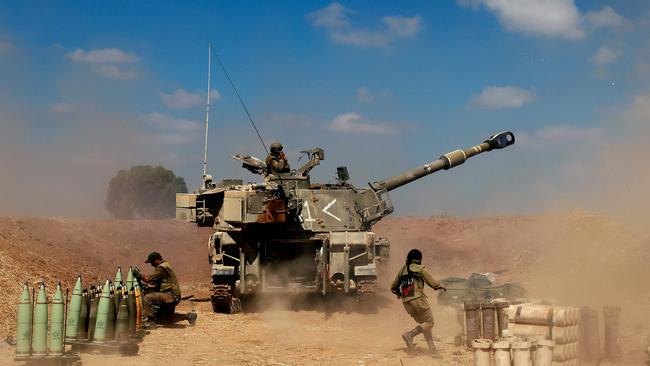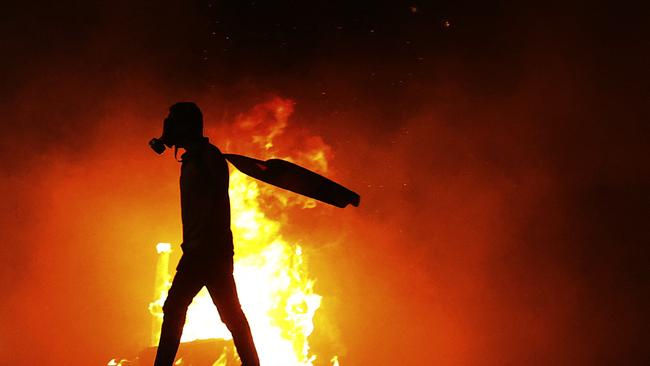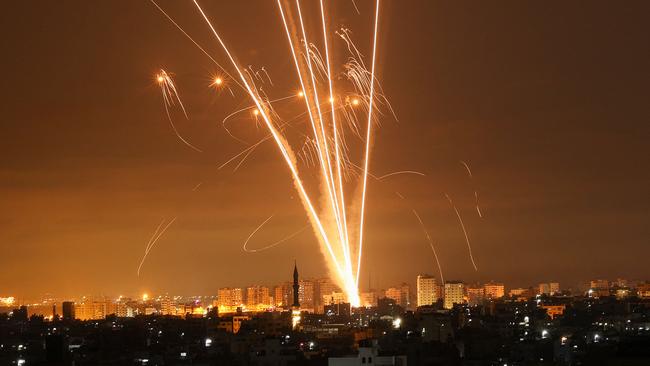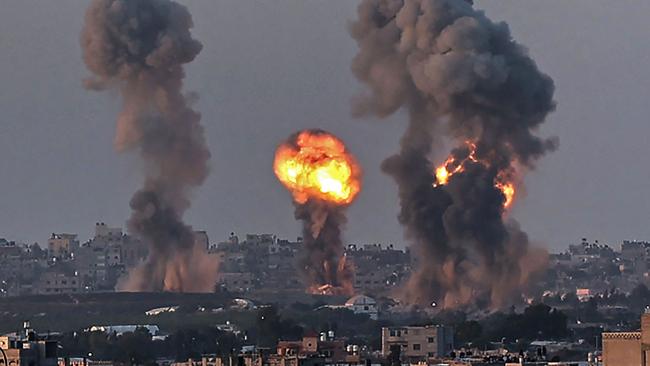Destruction from sky as rockets rain down on Israel and Gaza
The moment the curtain opened on to the current fraught situation in Israel can be identified precisely.

The moment the curtain opened on to the current fraught situation in Israel can be identified precisely. It came just after 6pm on Monday — with the air-raid sirens and then the sound of the explosions of seven rockets launched by Hamas at Jerusalem. Until that point, a slow gathering of antagonistic energies had been under way for three weeks.
The month of Ramadan provided the charged atmosphere. Perennial claims of a supposed Israeli threat to the Al-Aqsa mosque, and a property dispute between Jews and Arabs in the neighbourhood of Sheikh Jarrah focused the anger of the Palestinian Arab population.
But until 6pm on Monday, there still had been hope that the whole thing could be channelled. No one had been killed in Jerusalem, despite the stormy demonstrations and riots. There was hope that if perhaps the lid could be kept on the thing until Eid al-Fitr and the end of Ramadan, tempers would cool, the symbols could be put back in their boxes, and the flawed but notable coexistence that largely characterises daily life in the city and beyond it could resume.
I was covering a march by religious nationalist Israelis when the sirens came. The explosions were audible in the distance. Some people sought to take rapid cover beside vehicles or by running towards the adjacent municipal building. I remember most vividly that a great flock of birds suddenly filled the sky, all flying west, away from the sound of the exploding rockets that had just hit the neighbourhood of Mevasseret Zion.
A week on, we know just what was being heralded. The seven projectiles launched at Jerusalem were the beginning of a rocket offensive by the Hamas-controlled Gaza Strip against Israel, which at the time of writing has seen 1160 rockets launched at populated areas in the Jewish state. The rockets are continuing to fall daily. Overnight on Wednesday-Thursday, 130 projectiles were launched. The rocket campaign has been accompanied by scenes of intercommunal violence within Israel of a type not seen for many years.

Israel has hit back against the rocket assault. Israel Defence Forces artillery units rapidly were deployed along the Gaza border. Airstrikes began against Hamas targets in the Strip. Several senior figures of the movement have been assassinated. These include Bassem Issa, who commanded the movement’s Gaza City brigade. Seven Israelis have been killed, including one five-year-old, from the southern town of Sderot. Sixty-seven Palestinians are reported dead, including seven children.
These figures reflect the 90 per cent effective performance of Israel’s Iron Dome rocket defence system. The interception of Hamas rockets by Iron Dome can be witnessed daily on the Gaza border. Iron Dome’s early warning system and the construction of shelters in Israeli residential buildings further reduce the risk to the civilian population. The Hamas rulers of Gaza, by contrast, have provided no civilian shelters for Gaza’s population. The skills of the rocket launching teams are similarly sketchy. Of the Palestinians killed, eight, including two children, died when a rocket intended for Israel fell short and struck a home in Gaza.
Early efforts at mediation by Egypt and Russia have run aground. A meeting of the Israeli security cabinet convened on Wednesday voted unanimously to continue the Israeli counteraction, rapidly dubbed Operation Guardian of the Walls.
On a Wednesday trip to the Gaza border area, a build-up of ground forces for a possible incursion was apparent. The roads in the border area were largely deserted. The authorities had ordered people to remain in their homes and close to shelters, with more rockets expected.
A ground manoeuvre is not yet a certainty. But the IDF is set to present plans for such an option before the government in the coming days, the intention surely being, at the very least, to convey to the Hamas rulers in Gaza that such a move is a possibility. Elements of premier IDF regular units are being moved toward the Strip. I spotted a Merkava 4 tank on the highway close to the border. It was nestling behind a large tank transporter, as soldiers from the IDF’s 7th Armoured Brigade performed some routine maintenance tasks.

The soldiers were in good humour, shrugging off questions about their thoughts regarding a possible incursion. “If we do have to go in,” one of them said, “then let’s just go in to the end, once and for all, and get it done.”
A little later, in a quiet wooded area close to the border, I came across three Namer armoured personnel carriers of the Golani Infantry Brigade. The APCs were deployed, engines cold, in anticipation of a possible order to move in. The heavily armoured Namer is the replacement APC for the old Vietnam era M113s, which were hitherto the standard for the IDF infantry.
The Golani Brigade has a long account with Hamas in Gaza. In a famous incident in Operation Protective Edge in 2014, seven soldiers of the brigade were killed when the M113 they were travelling in stalled and was hit by a Hamas rocket-propelled grenade. Among other things, an IDF operation into Gaza will be a testing ground for the Namer.
It was proving a busy morning in the vicinity. An hour or so earlier, a couple of kilometres away, a Kornet anti-tank missile had fired at an IDF vehicle patrolling in Moshav Netiv Ha’asara along the borderline and killed First Sergeant Omer Tabib, of the Nahal Brigade. Hamas mortar fire was directed at the forces trying to evacuate the dead man and the wounded.
The rockets rained down on Ashkelon and Ashdod later that day. In Ashkelon, I visited one of the houses struck. The couple living there was in the shelter at the time. The rocket tore a hole in the building’s roof, showering masonry all around and leaving a wall precariously attached. “The Jews are too merciful,” was the laconic comment of Assaf, an Ethiopian Israeli who showed us around the building, where he also lives with his family.
The Gaza fighting and the rocket fire are an unexpected consequence of a clear decision by Hamas to use the Jerusalem tensions as part of an effort to recover primacy in Palestinian politics, and refocus regional and global attention on the Israeli-Palestinian conflict. From this point of view, the current situation is difficult but familiar, comprehensible.

An additional factor, however, has been apparent in recent days, which is without real precedent in the past half century, and which is causing alarm. This is the widespread mob violence, across Arab-majority and mixed towns, but reaching its most intense pitch in the mixed city of Lod. In Lod on Tuesday night, three synagogues were ransacked and burnt, numerous shops, restaurants and cars set on fire, Jewish civilians attacked. The mobs in many locations were chanting “Allahu akbar”, a testament to the religious fervour that is at the root of the current events. There is a problem of unlicensed weaponry in the Arab sector in Israel. In Lod, shots using live ammunition were fired on Wednesday night.
Similar scenes of violence and disorder took place in Akko, Ramle, Haifa and several smaller towns. On Wednesday night, with depressing predictability, a mob of young Jews in turn formed to engage in retaliatory actions against Arabs. More than 230 arrests have been made since the start of the unrest. But the general perception among many Israelis is that the authorities were largely caught flailing and unprepared by the outbreak of major violence on an unprecedented level within Israel itself.
For now the situation is fluid. On Thursday night, reports from some news outlets suggested that an incursion by the IDF into the Strip had begun. It became clear in the course of the night, however, that while the IDF was carrying out very large-scale standoff fire at targets inside Gaza, no entry of forces had taken place. The rockets are continuing to rain down, on Tel Aviv, Beersheva, Ashkelon and reaching the Jerusalem area. Israel’s counter-strikes are also ongoing, with the prospect of ground action looming in the background. The operation of Ben-Gurion airport has been severely disrupted because of fear of rocket and missile fire in the vicinity. Many flights have been cancelled. Others are being diverted to Ramon airport near Eilat, in the far south.

The mob violence continued overnight, and it remains to be seen if a major call-up of Border Police reservists on Thursday will start to stem the tide. Until now the West Bank has remained largely and notably quiet. Having successfully ignited Jerusalem, Gaza and many Arab-Israeli towns, Hamas now is doing its best to spread the unrest to this last component of the Arab population west of the Jordan River.
Abu Obaidah, spokesman for the Izz al-Din al-Qassam Brigades, Hamas’s military wing, on Thursday called on “our people in the West Bank”, to “fight the enemy in every field. The Qassam Brigades will be there at your back.” It is not certain yet if significant numbers will answer this call.
But the seven rockets launched at Jerusalem on Monday initiated a round of conflict still far from its conclusion, which has included forms and elements without precedent in this long and unresolved dispute.
Whether the Israeli system will prove sufficiently nimble and creative to rapidly develop adequate counter-responses will become apparent in the period ahead.
Jonathan Spyer is director of the Middle East Centre for Reporting and Analysis. He is the author of Days of the Fall: A Reporter’s Journey in the Syria and Iraq Wars.

To join the conversation, please log in. Don't have an account? Register
Join the conversation, you are commenting as Logout